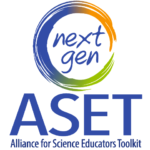
Science and engineering practice(s) (seps)
ASET SEP Tools
The ASET Science and Engineering Practice (SEP) Tools are designed to guide you to critically analyze how students are meaningfully engaged in the specific components of the SEP that you have selected to focus on for your lesson or unit. These specific components are outlined within the tool for each SEP.
Click on the grade band for the practice you are interested in to download the SEP Tool. These SEP Tools are continually evolving and may have changes or additions made as more input is provided.
SEP 1: Asking questions (for science) and defining problems (for engineering)
Grades K-2, 3-5 (pdf) (fillable-pdf) | Grades 6-8 (pdf) (fillable-pdf) | Grades 6-8, 9-12 (pdf) (fillable-pdf)
SEP 2: Developing and using models
Grades K-2, 3-5 (pdf) (fillable-pdf) | Grades 6-8 (pdf) (fillable-pdf) | Grades 6-8, 9-12 (pdf) (fillable-pdf)
SEP 3: Planning and carrying out investigations
Grades K-2, 3-5 (pdf) (fillable-pdf) | Grades 6-8 (pdf) (fillable-pdf) | Grades 6-8, 9-12 (pdf) (fillable-pdf)
SEP 4: Analyzing and interpreting data
Grades K-2, 3-5 (pdf) (fillable-pdf) | Grades 6-8 (pdf) (fillable-pdf) | Grades 6-8, 9-12 (pdf) (fillable-pdf)
SEP 5: Using mathematics and computational thinking
Grades K-2, 3-5 (pdf) (fillable-pdf) | Grades 6-8 (pdf) (fillable-pdf) | Grades 6-8, 9-12 (pdf) (fillable-pdf)
SEP 6: Constructing explanations (for science)
Grades K-2, 3-5 (pdf) (fillable-pdf) | Grades 6-8 (pdf) (fillable-pdf) | Grades 6-8, 9-12 (pdf) (fillable-pdf)
SEP 6: designing solutions (for engineering)
Grades K-2, 3-5 (pdf) (fillable-pdf) | Grades 6-8 (pdf) (fillable-pdf) | Grades 6-8, 9-12 (pdf) (fillable-pdf)
SEP 7: Engaging in argument from evidence
Grades K-2, 3-5 (pdf) (fillable-pdf) | Grades 6-8 (pdf) (fillable-pdf) | Grades 6-8, 9-12 (pdf) (fillable-pdf)
SEP 8: Obtaining, evaluating, and communicating information
Grades K-2, 3-5 (pdf) (fillable-pdf) | Grades 6-8 (pdf) (fillable-pdf) | Grades 6-8, 9-12 (pdf) (fillable-pdf)
Overview
The Framework for K-12 Science Education (NRC, 2012) outlines eight Science and Engineering Practices (SEPs) that should be used in classrooms to explore science content. While at first glance these practices may appear straight-forward, the description of each practice in the Framework (NRC, 2012) presents a much more complex vision. Each SEP consists of multiple components which are identified and described in the ASET SEP Tools linked above.
These eight Science and Engineering Practices
“describe what scientists do to investigate the natural world and what engineers do to design and build systems. The practices better explain and extend what is meant by “inquiry” in science and the range of cognitive, social, and physical practices that it requires. Students engage in practices to build, deepen, and apply their knowledge of core ideas and crosscutting concepts” (http://www.nextgenscience.org).
These practices should be used to explore various Disciplinary Core Ideas and Crosscutting Concepts throughout the year, while deepening students’ ability to meaningfully engage in and apply the SEPs. Use of these practices across multiple units will help deepen students’ understanding of the complexity of the practices in which scientists and engineers engage. Over the course of a year, units should be planned to apply the various components of each science and engineering practice in multiple settings. While you may bring in elements of various SEPs within one unit, you should select one (maybe two for a longer unit) of the SEPs to target for a given unit. In the case of a single lesson, one or two components of a single SEP should be targeted as a focus of the learning objective for that lesson.
Instructions for 3D Map
List the primary Science and Engineering Practice and its specific components in which students will engage within the lesson or unit.
ASET SEP Tools to Guide your Thinking
The ASET Science and Engineering Practice (SEP) Tools are designed to guide you to critically analyze how students are meaningfully engaged in the specific components of the SEP that you have selected to focus on for your lesson or unit. These specific components are outlined within the tool for each SEP. Through the use of these tools, you will be guided through the processes of:
- Breaking down the components and criteria of student engagement in each SEP at the 6-8 grade band
- Evaluating how well you are incorporating specific components of the target SEP into your instruction for the lesson or unit
- Reflecting upon what components may need strengthening or could be better addressed in your instruction around the designated SEP.
Within a single SEP, your lesson may focus on a subset of components that are included within this larger SEP and so some categories may be rated lower or higher depending on which you are focusing. While every component of your chosen SEP will probably not be evident in a single lesson or unit, your instruction over the course of the school year should help build students’ understanding of and ability to apply all components of the SEP.
ASET Science and Engineering Practices Tools Caveats
These tools are not meant to be used as a teacher evaluation tool, to review all eight SEPs in a single lesson or unit, or to imply that every component of the SEP should be included within a single lesson or unit.
External Resources on the Science and Engineering Practices
References
National Research Council. (2012). A Framework for K-12 Science Education: Practices, Crosscutting Concepts, and Core Ideas. Committee on a Conceptual Framework for New K-12 Science Education Standards. Board on Science Education, Division of Behavioral and Social Sciences and Education. Washington, DC: The National Academies Press.
